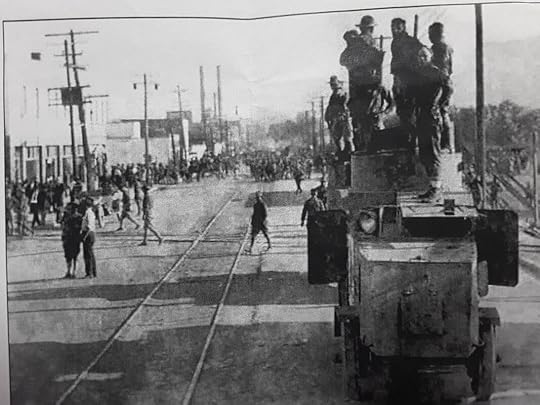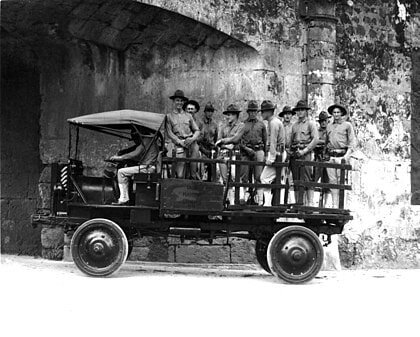The Jeffery: Modern Mule
Early in the 20th century, the U.S. Army decided that mechanization was the wave of the future. In 1912, it requested proposals for a truck that could take the place of the four-mule teams used to haul standard one-and-a-half-ton loads of equipment, supplies and men. One of the companies that responded was the Thomas B. Jeffery Company, in Kenosha, Wisconsin.
The Jeffery Company began their development by buying and studying a truck developed by The Four Wheel Drive Auto Company (FWD). They soon sold it and began their own design from scratch. By July 1913, they had developed a prototype of the Jeffery Quad that was ready for public demonstration of its capabilities.
 The Jeffery designed a four-wheel-drive truck, known as the "Quad" or "Jeffery Quad" that was sturdier than anything that had come before it. It had four-wheel brakes and an innovative four-wheel steering system that allowed the rear wheels to track the front wheels around turns. This meant that the rear wheels did not have to dig new "ruts" on muddy curves. A very high ground clearance allowed it to drive through mud up to its hubcaps. The wheels were the same as those used on locomotive cars, with the addition of a thin rubber tire. When they were used near train tracks, the tire could be taken off and the Quad set on the rails.
The Jeffery designed a four-wheel-drive truck, known as the "Quad" or "Jeffery Quad" that was sturdier than anything that had come before it. It had four-wheel brakes and an innovative four-wheel steering system that allowed the rear wheels to track the front wheels around turns. This meant that the rear wheels did not have to dig new "ruts" on muddy curves. A very high ground clearance allowed it to drive through mud up to its hubcaps. The wheels were the same as those used on locomotive cars, with the addition of a thin rubber tire. When they were used near train tracks, the tire could be taken off and the Quad set on the rails.
 Quads on a muddy road in Mexico Jeffery Quads first saw service during the Army’s 1916 Punitive Expedition through Mexico. General John “Blackjack” Pershing used a mix of Quads and mule-driven wagons to transport troops and supplies. He also had two Quads that had been specially modified with armor.
Quads on a muddy road in Mexico Jeffery Quads first saw service during the Army’s 1916 Punitive Expedition through Mexico. General John “Blackjack” Pershing used a mix of Quads and mule-driven wagons to transport troops and supplies. He also had two Quads that had been specially modified with armor.
 Armored Jeffery Quad at Pancho Villa State Park, New Mexico The Jeffery Quad Armored Truck, also known as Armored Car No. 1, was not the first armored car -- several National Guard units had already had their own designed – but it was the first one built by the U.S. Government specifically for Army’s use. It was designed to support combat forces. It had armored plate made by the Bethlehem Steel Corporation and two manually operated turrets. Three light machine guns, a Bennett-Merier and 2 Colt “Potato Diggers,” provided the firepower. Neither vehicle was reported to have seen military action.
Armored Jeffery Quad at Pancho Villa State Park, New Mexico The Jeffery Quad Armored Truck, also known as Armored Car No. 1, was not the first armored car -- several National Guard units had already had their own designed – but it was the first one built by the U.S. Government specifically for Army’s use. It was designed to support combat forces. It had armored plate made by the Bethlehem Steel Corporation and two manually operated turrets. Three light machine guns, a Bennett-Merier and 2 Colt “Potato Diggers,” provided the firepower. Neither vehicle was reported to have seen military action.
 When Pershing led the Army overseas, he brought the Quad with him. Its ability to negotiate France and Belgium’s muddy, rough, and unpaved roads made it the workhorse of the Allied Expeditionary Force.
When Pershing led the Army overseas, he brought the Quad with him. Its ability to negotiate France and Belgium’s muddy, rough, and unpaved roads made it the workhorse of the Allied Expeditionary Force.
Quads were also used by the United States Marine Corps from 1915 through 1917, during their occupation of Haiti, and of the Dominican Republic. Marines in Santo Domingo, 1916 Approximately 11,500 Jeffery and Nash Quads were built between 1913 and 1919. They continued to be produced until 1928, but their reliability and ability to negotiate difficult terrain that challenged more modern trucks meant that civilians to use these slow, but steady workers until into the 1950s.
Marines in Santo Domingo, 1916 Approximately 11,500 Jeffery and Nash Quads were built between 1913 and 1919. They continued to be produced until 1928, but their reliability and ability to negotiate difficult terrain that challenged more modern trucks meant that civilians to use these slow, but steady workers until into the 1950s.
Jennifer Bohnhoff writes historical novels from her home high up in the mountains of central New Mexico. A Blaze of Poppies: A Novel About New Mexico and World War I will be published in October 2021.
The Jeffery Company began their development by buying and studying a truck developed by The Four Wheel Drive Auto Company (FWD). They soon sold it and began their own design from scratch. By July 1913, they had developed a prototype of the Jeffery Quad that was ready for public demonstration of its capabilities.
 The Jeffery designed a four-wheel-drive truck, known as the "Quad" or "Jeffery Quad" that was sturdier than anything that had come before it. It had four-wheel brakes and an innovative four-wheel steering system that allowed the rear wheels to track the front wheels around turns. This meant that the rear wheels did not have to dig new "ruts" on muddy curves. A very high ground clearance allowed it to drive through mud up to its hubcaps. The wheels were the same as those used on locomotive cars, with the addition of a thin rubber tire. When they were used near train tracks, the tire could be taken off and the Quad set on the rails.
The Jeffery designed a four-wheel-drive truck, known as the "Quad" or "Jeffery Quad" that was sturdier than anything that had come before it. It had four-wheel brakes and an innovative four-wheel steering system that allowed the rear wheels to track the front wheels around turns. This meant that the rear wheels did not have to dig new "ruts" on muddy curves. A very high ground clearance allowed it to drive through mud up to its hubcaps. The wheels were the same as those used on locomotive cars, with the addition of a thin rubber tire. When they were used near train tracks, the tire could be taken off and the Quad set on the rails. Quads on a muddy road in Mexico Jeffery Quads first saw service during the Army’s 1916 Punitive Expedition through Mexico. General John “Blackjack” Pershing used a mix of Quads and mule-driven wagons to transport troops and supplies. He also had two Quads that had been specially modified with armor.
Quads on a muddy road in Mexico Jeffery Quads first saw service during the Army’s 1916 Punitive Expedition through Mexico. General John “Blackjack” Pershing used a mix of Quads and mule-driven wagons to transport troops and supplies. He also had two Quads that had been specially modified with armor. Armored Jeffery Quad at Pancho Villa State Park, New Mexico The Jeffery Quad Armored Truck, also known as Armored Car No. 1, was not the first armored car -- several National Guard units had already had their own designed – but it was the first one built by the U.S. Government specifically for Army’s use. It was designed to support combat forces. It had armored plate made by the Bethlehem Steel Corporation and two manually operated turrets. Three light machine guns, a Bennett-Merier and 2 Colt “Potato Diggers,” provided the firepower. Neither vehicle was reported to have seen military action.
Armored Jeffery Quad at Pancho Villa State Park, New Mexico The Jeffery Quad Armored Truck, also known as Armored Car No. 1, was not the first armored car -- several National Guard units had already had their own designed – but it was the first one built by the U.S. Government specifically for Army’s use. It was designed to support combat forces. It had armored plate made by the Bethlehem Steel Corporation and two manually operated turrets. Three light machine guns, a Bennett-Merier and 2 Colt “Potato Diggers,” provided the firepower. Neither vehicle was reported to have seen military action. When Pershing led the Army overseas, he brought the Quad with him. Its ability to negotiate France and Belgium’s muddy, rough, and unpaved roads made it the workhorse of the Allied Expeditionary Force.
When Pershing led the Army overseas, he brought the Quad with him. Its ability to negotiate France and Belgium’s muddy, rough, and unpaved roads made it the workhorse of the Allied Expeditionary Force.Quads were also used by the United States Marine Corps from 1915 through 1917, during their occupation of Haiti, and of the Dominican Republic.
 Marines in Santo Domingo, 1916 Approximately 11,500 Jeffery and Nash Quads were built between 1913 and 1919. They continued to be produced until 1928, but their reliability and ability to negotiate difficult terrain that challenged more modern trucks meant that civilians to use these slow, but steady workers until into the 1950s.
Marines in Santo Domingo, 1916 Approximately 11,500 Jeffery and Nash Quads were built between 1913 and 1919. They continued to be produced until 1928, but their reliability and ability to negotiate difficult terrain that challenged more modern trucks meant that civilians to use these slow, but steady workers until into the 1950s.Jennifer Bohnhoff writes historical novels from her home high up in the mountains of central New Mexico. A Blaze of Poppies: A Novel About New Mexico and World War I will be published in October 2021.
Published on October 02, 2021 23:00
No comments have been added yet.



